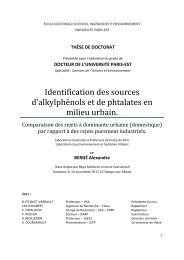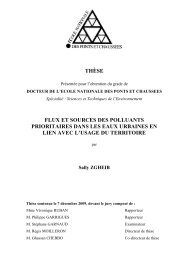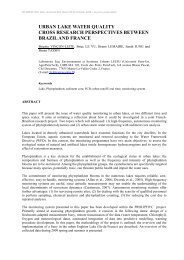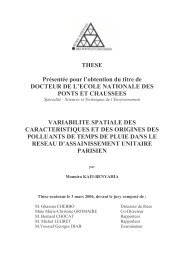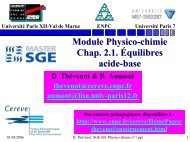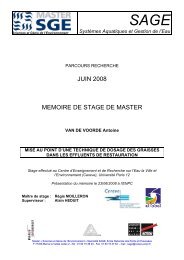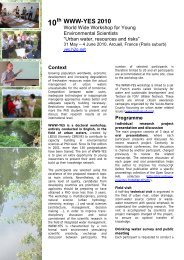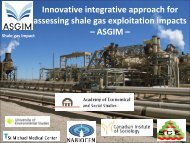INTRODUCTION17 Problem of land use and water supply in urbanarea: the case of the city of Touba, Senegal.Papa Demba CamaraUniversity Paris 8 – Institut d’Etudes Européennes2, rue de la liberté 93526 Saint Denis – France3, rue Auguste Poullain Apt 2208 - 93200 Saint Denis - France5 Claremont Road UKpape27@hotmail.frAbstractThis study focuses on the relation between land use and water supply. It resultsfrom direct observations coupled by semi-structured interviews with localactors. In urban areas of Senegal, water is drawn from two sources, from thedrinking water network and from traditional wells. Our study focuses on thecity of Touba, a city which is singled out by its recent character (new city) andby her religious inclination (religious city). The naturals conditions areunfavorable: low rainfall, depth of the groundwater with wells brought up ratesin salt and fluorine. Two types of land use have been identified in the city: atraditional occupation and modern occupation. They have real consequenceson water supply. A city of 700000 inhabitants, Touba hosts two millionspilgrims every year. Water quality and the quantity have always been the mainproblem for the people and pilgrims. The first consequence of water lack isunhealthy. Water-borne diseases caused by pathogen agents appear in this cityso endemic.Keywordslack, pathogens, quality, water borne disease, water supply, wellThe galloping demography of black Africa countries and the exponential urbanization of somecities of the continent so disparaged just after independence (1960) that it does not seem to beready to stop. At the beginning of the 3 rd millennium, a new urban mapping is taking shape: wetalk about urban revolution. Next to the ancient city, some new cities came into existence, thesame case with Touba Senegal, very recent city. The cities of second generation contributecertainly to ease congestion in capitals and to readjust the urban mapping. But like the oldcities the new cities also have certain problems such as poor planning systems, anarchic landuse, deficient water supply, no sewerage systems etc.This essay is about the relationship between the systems of drinking water and land ownershipin urban areas. This is not an exhaustive essay because it needs more research for the problemsto be identified and because of the time constraints it is difficult to do the thorough analysis.The study carries reconciliation, generally speaking, on the concept of sustainabledevelopment between fast economic growth and the environment. But in this particularcontext, we are talking about the relationship between population growth in Africa and itsenvironment. Indeed, in countries with low economic development, demographic weightdrastic affect on the environment.This study in the first part describes the city of Touba, what makes its prominent, is the waythe space is occupied and used. Touba the religious city suffers from the problem of limitedwater supply. Touba is a holy city, but because of contaminated water it seems literally“mucked up”. This study will try to cover this subject in the second part, and finally, the lastpart will focus on inherent health problems associated with the water in Touba.MATERIEL AND METHODSThis work examines the relations between land usage and water supply in urban areas. Itresults from direct observations coupled by semi-structured interviews with local authorities,people and doctors. We visited some drillings, health centres and interviews some families.Basically our methodology can be broken down into three steps:Documentary research:It allowed the collection of secondary data and guided us to visit the chosen places andinterview the most likely affected families.Semi-structured interviewsOur study is based on a qualitative approach purpose of which is get from the locals first handinformation. Thus we discovered that it is in the relations of one-to-one debate that the localsdevote themselves more and we benefited from their personal experience.ObservationOur presence in the field has enabled us to witness what the locals face to get basic supply ofwater. Easy access to water is not an easy mean in Touba. The locals travel about 20 miles toget access to drinking water which might not be clean water.Keep in mine that this study was made easier by the various people whom we met during ourfield visit and was able to provide us with accurate information we need for this research. Welike to take this opportunity to thanks them for all their support and wish them all the best.TOUBA: BETWEEN TRADITION AND MODERNITYLocated around 200 km east of Dakar, Touba is a Muslim holy city of the mourid brotherhood.The city of Touba was founded in 1887 by Sheikh Ahmadou Bamba. In just few years ofurbanization, Touba has become the second biggest city in Senegal after the capital Dakar.With an area of over 20,000 hectares, its urbanization was mainly facilitated by a paternalisticland system, based on donation or a free attribution of plots, but also marked by speculation.The development of the city is link to the great pilgrimage which celebrates every year thedeparture into exile of the founder of the mourid brotherhood, Sheikh Ahmadou Bamba. Thispilgrimage called “magal” means, celebration in Wolof. The intersection between the town andWWW-YES 2008, Paris 13 – 16 May 2008 149WWW-YES 2008, Paris 13 – 16 May 2008 150
the village makes Touba in between tradition and modernity. So that is one foot in the city, another one out. This gives to the city a mixed configuration.Located in the Senegalese peanut basin, Touba is facing a growing desertification hence thedrop in profitability of agricultural activities. Rainfall is increasingly weak; it varies between300 and 600 mm of rain per year. Due to its geographical location, the city of Touba hasSudano-sahelian climate hot and dry. In the dry season, it is subject to the influence of hot anddrying harmattan in the daytime and cool at night. Temperatures range between 27 and 46 °C.The soil type is Dior, very sandy therefore very often degraded and washed. Its water retentioncapacity is very low. The depth of the water table is 25 m.In 2007, according to official estimates, Touba has about 700,000 people. The religiousinclination of this city makes the population can increase up to 2 millions people during the“magal” annual religious appointment due to pilgrim from around Senegal. Touba record thestrongest population growth of settlements of Senegal, more than 10%. According to anunofficial source, this growth would increase by 19% in 2020. This growth is owed to theinflux by the migration of villagers and even some city dwellers to the city of Touba. Most ofthe villages around the city are almost empty due to this migration.Two types of land use have been identified in the mourid city. The first said traditional rhythmwith the patterns of life of the occupiers. The voluntary migration of rural people towardTouba driven to an anarchic occupation of the area. According to our interlocutor, the countrypopulation which migrate to Touba has tendency once installed in the city, to rebuild their ownenvironments and to extend the same socioeconomic practices. This is due to socioeconomicreasons.Indeed, the new urbanites justify their arrival in town by the difficult living conditions for theirplace of origin. They come in effect from villages hit by an impairment climate, with a weakrainfall and combined with the drying of wells. But these people are in danger by living in theoutskirts of Touba. Because they are not too keen of hygiene while the quality of water whichthey use doubtful. These add to the low endowment in health infrastructures. These ruralnewly installed in urban areas, are not used to visiting the hospital quickly in the event ofoccurrence of the first symptom of disease. As long as they are not seriously ill, they won’t seea doctor. They are therefore at the mercy of water-borne diseases because, in the lack oftreatment started quickly, cholera for example can create a quick and strict desiccate.The second type of occupation says modern is a form of contemporary occupation. Residentsare building modern houses. It is urban dweller’s fact in retirement or immigrants who are indeveloping countries. This rush toward Touba of dwellers from other cities is due to religiousfactor, the majority of people who migrate to Touba consider their trip as an impetus to therapprochement of the great holy city. In the individual and collective representation of thesepeople, this rapprochement is a religious accomplishment. Unlike the old rural, they are moreattentive to the basics of hygiene. They tend to bleach for example watershed water beforeconsuming it. In addition, in case of demonstrations symptoms of diseases they rushed tohospital. Anyway, this migration has real consequences on the health plan. Often located in theurban fringe, these newcomers do not have easy access to the drinking fountains and they haveno tap at home. While living in an urban environment they travel thousands of meters to obtainwater. Because in the city of Touba, networks drinking water do not cover the whole urbanarea, the paradox is that the infrastructure of drinking water and as well as sanitation systemsdo not evolve at the same pace as the city. The offer is becoming increasingly lower thandemand. This is the paradox of Touba.WATER FROM TOUBA: AWARE OF DANGERCan the rural water supply provide for the urban environment? That is unfortunately thepeculiarity of this city. Despite its rapid urbanization and its high population growth false,water supply is always provided through the drillings and wells. Touba is synonymous withlack of water; and also rhymes with waterborne epidemics. Since, 20 years this "City of God"suffers from the lack of water. If it is not the lacking of the quantity so, the quality will beproblematic; however water of Touba has always had a bitter taste. Indeed, the city is stillconfronted with a problem of salinity. Most capture groundwater wells with high levels of saltand fluorine. Generally higher than those recommended by the WHO (World HealthOrganization): 1.5 g / l for salt and 0.5 to 1.5 m / l for fluoride.Despite the existence of 17 drillings in the city and over 150 linear kilometres for the supply,the water supply is worst during “magal”, because during “magal” the city dropped abruptly to60000 cubic metres of water daily to 600000 cubic meter because people have switched from700 000 to 2 000 000 people. During this period, water is placed under surveillance in the citybecause whenever there is water shortage, the local population and the pilgrims use the poolsopen and wells. In Touba during watershed people use the wells or the basins, a kind of tank tocope with water shortages. For the magal administrative and religious authorities ensure lot ofwater. In case of disruption of supply, they are trucks away from supplying the city during thisperiod to prevent the population and pilgrims to consume water from the basins. During a visitto a house on the outskirts of Touba we asked the mother “how long this water remained in thebasin?” She answers, “Since 9 days.” “Are you going to drink this water whenever there iswater shortage?" She answers again, "Yes we are going to drink it. It is used whenever thereis water lack. You know Touba is a dry zone, we run out of water very often is why we aretaking our precautions.”Epicentre of cholera Touba is also the breeding ground for water-borne diseases. According tothe point of view of doctors, the water problem is the hub of the spread of cholera vibrio inTouba. All patients hospitalized with cholera in the department of infectious diseases havebeen to Touba during the magal. This revelation is from the head doctor of Infectious Diseasesof Dakar. Each year, more than 50 cases of cholera were hospitalized at the department ofinfectious diseases. 'When an individual does not have access to drinking water, he drinksanything. And all cases received the services of Infectious Diseases have in common the factthat they consumed water from wells, the water that comes from the watershed, a kind of openwells. But, warns the head of Infectious Diseases, 'until there managed the water issue inTouba and the problem of septic tanks every year, we may have to cope with outbreaks ofcholera '.In water diseases, as soon as there gathering of people and there is no access to drinking water,there is a risk of cholera. The problem of cholera is not a medical problem, but a problem ofquality of life. It is a health problem; the environment is an issue of environmental sanitation,access to clean water, live in conditions that have latrines, and so on. And for the prevention ofthis disease, there must be drinking water available to the people, sensitise them to respect thebasic rules of hygiene such as washing hands before touching food.Touba is also an unhealthy city. There is acute a real problem of waste management. Indeed,WWW-YES 2008, Paris 13 – 16 May 2008 151WWW-YES 2008, Paris 13 – 16 May 2008 152



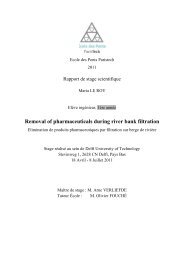
![[pastel-00730831, v1] Incidence des pratiques d'entretien ... - LEESU](https://img.yumpu.com/50938896/1/184x260/pastel-00730831-v1-incidence-des-pratiques-dentretien-leesu.jpg?quality=85)

